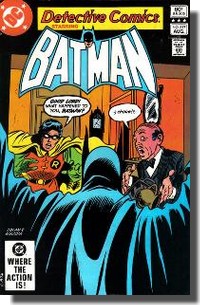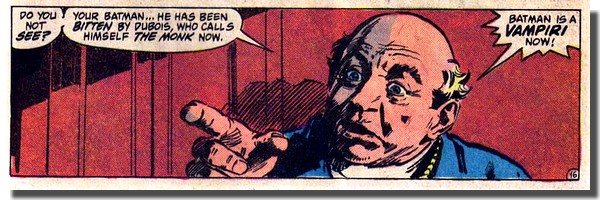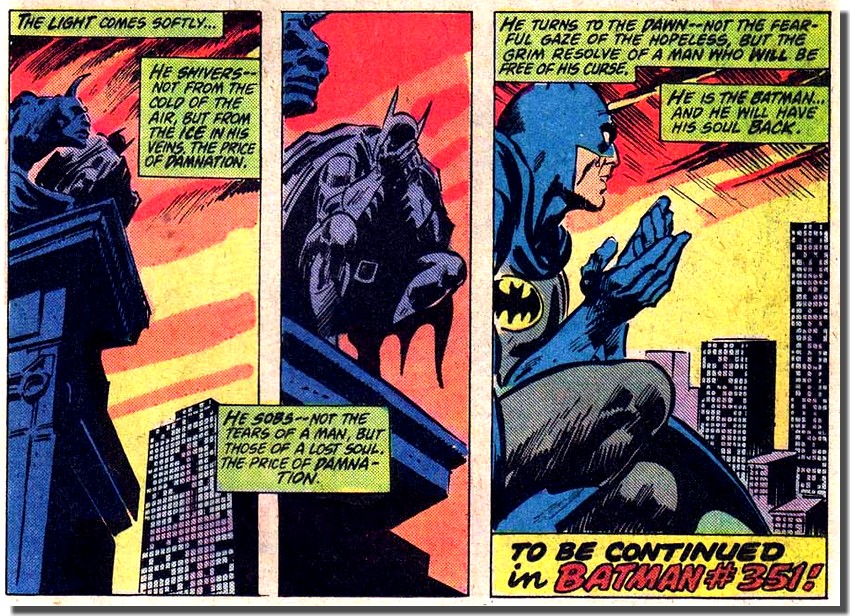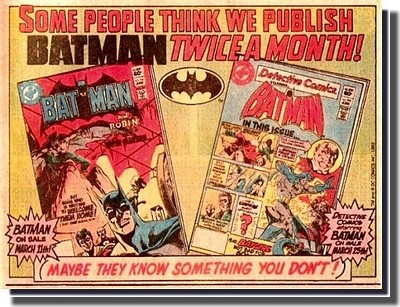 |
||||
(PART THREE) DETECTIVE COMICS
#517 |
||||
|
||||
|
||||
|
||||
| Confronted by an alarmed Alfred, Batman tells his faithful companion to stay clear, as the creature he has now been turned into forces more and more cravings and instincts onto Bruce Wayne which he may no longer be able to control any moment soon. | ||||
|
||||
| Meanwhile,
across Gotham, "Boss" Thorne is going over the
photographs which publisher Morton Monroe had stolen from
the desk of Vicki Vale - and reaches the same conclusion
which the original owner arrived at: that the Batman is
in fact... Bruce Wayne. Back at Wayne Manor, Alfred prepares tea for his late night visitor and secretly rings up Christopher Chance, the Human Target, whom he had contacted earlier, but now urging him to come as quickly as possible due to an emergency situation - to which Chance agrees. A few minutes later, Father Green relates a strange tale to an increasingly confused and worried Alfred. It is the tale of how plantation owner Louis Dubois mistreated his workers in post civil war New Orleans, and how those who suffered under him brought about a terrible curse, turning both Dubois and his sister into vampires - now known as the Monk and Dala. Father Green concludes his narrative with the observation that the knows that the Batman has taken refuge in Wayne Manor, and that he must be helped - much to the chagrin of Alfred, who senses yet another threat to Bruce Wayne's secret identity. As the new morning dawns, the party folk at Dala's mansion start to leave, including Vicki Vale - who once again wonders where Bruce Wayne may have gotten to. Unbeknownst to her, he is greeted by the rising sun in the guise of the Darknight Detective, watching across the roof tops of Gotham City - and determined to fight back and free himself of the terrible curse inflicted upon him by the Monk. To be continued - in Batman #351... |
||||
|
||||
REVIEW & ANALYSIS Readers who only followed Detective Comics but not Batman got their first taste of the vampire story as it finally branched into Detective Comics after the first two parts to this arc had featured in Batman only (#349 and #350) - and what a bitter taste this was indeed. And for readers who followed both titles, Detective Comics #517 provided the confirmation of what had to expected, if not feared, from the events depicted in Batman #350 - that the Darknight Detective had indeed been turned into a vampire by the Monk (the term used by Father Green throughout the entire story is vampiri, which is somewhat marked and conveys a slight old world atmosphere; however, it is actually a Serbian plural form and thus well researched by Conway, as it harks back at one of the generally assumed origins of the word). To all intents and purposes, Detective Comics #517 was a game changer for the semi-monthly crossover between Detective Comics and Batman as it represents the first issue which truly required readers to have read the previous issue of Batman - for otherwise, the story really made very little sense at all and would require a lot of guesswork in order to fill in multiple blanks which would arise if readers were unaware of previous developments regarding Dala and the Monk. |
||||
|
||||
| So maybe
linking up Detective Comics and Batman
back to back through crossovers would not be as
commercially successful in 1982 as DC would have hoped
for, but from a content point of view, it worked
extremely well - even as Gerry Conway tackled a plot
device which presented all sorts of pitfalls, i.e. having
Batman face a supernatural villain. Working the storyline
and the characters in a well paced manner, without a rush
and one step at a time, Conway now went right down to the
end of the line - by having Batman afflicted by the Monk
and turned into a vampiric being himself. It was a highly radical step to take - and possibly the most dramatic plot development imaginable as Batman (who was essentially born out of Bruce Wayne's willpower and self-determination) was slowly losing his grip... on himself, his actions - everything. Could he find a way to overcome this terrible situation he now found himself in, and fight back and - even become normal again? It could have gone terribly wrong and just looked plain silly, but Gerry Conway had set up the entire story arc so cleverly that - almost surprisingly - it worked, and it worked really well. This was no mean achievement, as a later incarnation of a vampiric Batman in 1991 by Doug Moench and Kelley Jones was set in the so-called Elseworlds, i.e. a completely different reality. Conway, however, managed to fit the idea into an actual real world concept in a (somehow) believable and captivating way. One important element was to change the origin of The Monk (Batman's first supernatural villain ever) as well as the persona himself - into something far more specific and und understandable in comparison to his very oblique and at the same time highly generic background as "a Hungarian vampire" in Detective Comics #31 (September 1939). It just flowed and worked well, and an immensely important part of this was the simply stunning pencilwork of Gene Colan, which brought it all to life in a truly cinematic way. Naturally, this was Colan's own and favoured territory, with shadows aplenty and a vampire or two on the loose, but Colan's artwork in Detective Comics #517 and, indeed, the entire Monk storyline, is a fine example of the very best in comic book art. |
||||
COMMENTS FROM THE BATCAVE |
||||
|
||||
|
||||
|





